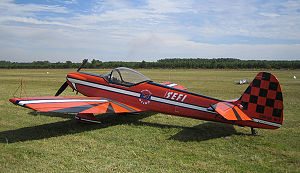| Mudry CAP 20 | |
|---|---|

| |
| CAP-20 #7 in 2007 | |
| Role | Single-seat aerobatic monoplaneType of aircraft |
| Manufacturer | Avions Mudry |
| First flight | 15 January 1976 |
| Introduction | November 1976 |
| Produced | November 1976 to July 1979 |
| Number built | 12 |
The Mudry CAP 20 is a French family of aerobatic competition single seater monoplanes.
Design and development
The Mudry CAP 20 was developed at the same time as the CAP 10, as a single-seat aerobatic version. It was followed by a lightweight version designated the CAP 20L which in turn was replaced by the CAP 21 with more advanced wing.
The CAP 20 was developed as a single-seat acrobatic version of the company's CAP 10; it was used by the French Air Force's flying demonstration team, Equipe de Voltige Aerienne. The CAP 20L is externally similar to the 20, but is a structurally new design. The wing planform is more angular; the dihedral is less (1.5 degrees); the fuselage cross-section is distinct, with a rounded top (the 20 used a triangular-shaped top deck). Its dimensions are slightly reduced, and the empty weight was considerably lower (the L stands for leger, or light).
Production of the 20L was suspended in July 1979, when managers decided to improve its wing design. However, when the new wing was introduced, the overall design was tweaked to the point that a new designation (CAP 21) was used to designate the series.
The CAP-21 was then developed as the CAP-230.
Variants
- CAP 20
- Initial version, 9 aircraft (1 CAP-20, 3 CAP-20A, 4 CAP-20B, 1 CAP-20E)
- CAP 20L-180
- Lightweight variant powered by a 180 hp (134 kW) Avco Lycoming piston engine, only one aircraft produced.
- CAP 20LS-200
- Lightweight variant powered by a 200 hp (149 kW) Avco Lycoming IO-360-RCF piston engine, 12 aircraft.
- CAP 21
- Improved version with new advanced aerofoil section wing and new landing gear, 18 aircraft.
- CAP-21-260
- A CAP-21 retrofitted with a 260 hp (194 kW) engine.
Operators
- French Air Force (CAP 20)
Specifications (CAP 21)
Data from Jane's All The World's Aircraft 1988-89
General characteristics
- Crew: 1
- Length: 6.46 m (21 ft 2 in)
- Wingspan: 8.08 m (26 ft 6 in)
- Height: 1.52 m (5 ft 0 in)
- Wing area: 9.2 m (99 sq ft)
- Airfoil: V16F
- Empty weight: 500 kg (1,102 lb)
- Max takeoff weight: 620 kg (1,367 lb)
- Powerplant: 1 × Textron Lycoming IO-360-A1B 4-cyl. air-cooled horizontally-opposed piston engine
- Propellers: 2-bladed Hartzell constant-speed propeller
Performance
- Maximum speed: 299 km/h (186 mph, 161 kn)
- Cruise speed: 265 km/h (165 mph, 143 kn)
- Stall speed: 85 km/h (53 mph, 46 kn)
- Never exceed speed: 380 km/h (240 mph, 210 kn)
- Endurance: 2 hours
- g limits: +6 -5
- Rate of climb: 14 m/s (2,800 ft/min)
References
- The prototype, fitted with a 180 hp engine, first flew from Bernay, with Louis Pena at the controls. While completing certification flights at the Centre d'Essais en Vol (Istres), it appeared at the 8th World Aerobatic Championships in Kiev. In mid-October 1976 the airframe was relegated to structural testing at CEAT (Toulouse), and did not fly again.
- The first of five pre-production units was flown on 6 November 1976, fitted with a 200 hp engine. This and all subsequent units were designated CAP 20 LS-200.
- ^ John W.R. Taylor, ed. (1988). Jane's All the World's Aircraft 1988-89. London: Jane's Information Group. p. 79. ISBN 0-7106-0867-5.
- Taylor, John W.R. (1988). Jane's All The World's Aircraft 1988-89. Coulsdon, UK: Jane's Defence Data. p. 79.
- The Illustrated Encyclopedia of Aircraft (Part Work 1982-1985). Orbis Publishing. p. 2572.
- Mondey, David (1982). Encyclopedia of the World's Commercial and Private Aircraft. New York City: Crescent Books. p. 201.